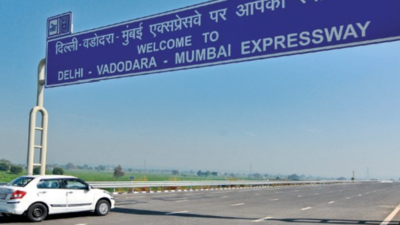Top Searches
- News
- City News
- gurgaon News
- AI cameras, speed radars to watch you on new e-way
AI cameras, speed radars to watch you on new e-way

These high-resolution AI-enabled devices will detect any violations or emergencies, and alert the central control room in Alipur, Sohna
GURUGRAM: An extensive network of around 1,500 cameras, one or more for every kilometre, will dot the Gurugram-Dausa stretch of Delhi-Mumbai Expressway to keep a close eye on every traffic movement and violations on the high-speed corridor.
These high-resolution AI-enabled devices will detect any violations or emergencies, and alert the central control room in Alipur, Sohna. In case of offences such as speeding, wrong-side driving, illegal parking and lane violations, operators at the centre will analyse data and issue the challan.
If a vehicle comes to an abrupt halt, speakers mounted on poles along the highway will blare a control room operator’s instructions to keep moving, officials of the National Highways Authority of India (NHAI) said on Tuesday, giving details of the plan to oversee seamless movement on the 1380km expressway.
On Sunday, Prime Minister Narendra Modi inaugurated the first stretch of the highway, a 246km portion between Sohna (Gurugram, Haryana) and Dausa (Rajasthan) that is expected to open for regular traffic from Wednesday. India’s longest expressway, once finished, will connect India's two largest metropolises after traversing six states.
A sub-control room for managing traffic on the Haryana section of the expressway has been made operational in Alipur, Sohna. The area will also host the central control room for the entire expressway.
Driving over the 120kmph speed limit will automatically generate challans. There will be CCTV cameras equipped with artificial intelligence at every kilometre. In addition, speed cameras, radars and automatic violation detection systems will be installed 10 kilometres apart on the entire route.
“The speed limit on the highway is 120km per hour. Any vehicle that goes above 125km will be automatically fined,” an NHAI official said.
The CCTV cameras chosen for the e-way will also have a long range. “These devices can record the registration number of a vehicle that’s moving at a speed of 240kmph,” the official cited above said. The expressway has been planned as a no-stop zone.
In case of any unscheduled stop, the cameras will alert the control room operators, who will then ask the vehicle’s driver to move via speakers mounted on poles along the road. A patrolling unit will be sent in if instructions aren’t followed. At this nerve centre, the cameras will also give operators visuals of any emergency or accident, consequently allowing them to act fast.
The patrolling units will have cars with multiple cameras to relay visuals of any accident site to the control room as well. “The patrol units will be tasked with providing immediate assistance to accident victims and others who are in need… We are trying to develop a system under which a response team can reach the accident spot within 10 minutes,” said the official.
Emergency telephones are to be installed every 2 kilometres if anyone on the e-way wants to get in touch with the control room. Digital signboards will also display real-time information on traffic congestion, accidents and other relevant information to keep drivers on the highway updated and prepared.
NHAI officials said the central control room in Alipur will be developed in the next three months. A sub-control room is already monitoring around 78km of the Haryana stretch of the e-way.
These high-resolution AI-enabled devices will detect any violations or emergencies, and alert the central control room in Alipur, Sohna. In case of offences such as speeding, wrong-side driving, illegal parking and lane violations, operators at the centre will analyse data and issue the challan.
If a vehicle comes to an abrupt halt, speakers mounted on poles along the highway will blare a control room operator’s instructions to keep moving, officials of the National Highways Authority of India (NHAI) said on Tuesday, giving details of the plan to oversee seamless movement on the 1380km expressway.
On Sunday, Prime Minister Narendra Modi inaugurated the first stretch of the highway, a 246km portion between Sohna (Gurugram, Haryana) and Dausa (Rajasthan) that is expected to open for regular traffic from Wednesday. India’s longest expressway, once finished, will connect India's two largest metropolises after traversing six states.
A sub-control room for managing traffic on the Haryana section of the expressway has been made operational in Alipur, Sohna. The area will also host the central control room for the entire expressway.
Driving over the 120kmph speed limit will automatically generate challans. There will be CCTV cameras equipped with artificial intelligence at every kilometre. In addition, speed cameras, radars and automatic violation detection systems will be installed 10 kilometres apart on the entire route.
“The speed limit on the highway is 120km per hour. Any vehicle that goes above 125km will be automatically fined,” an NHAI official said.
The CCTV cameras chosen for the e-way will also have a long range. “These devices can record the registration number of a vehicle that’s moving at a speed of 240kmph,” the official cited above said. The expressway has been planned as a no-stop zone.
In case of any unscheduled stop, the cameras will alert the control room operators, who will then ask the vehicle’s driver to move via speakers mounted on poles along the road. A patrolling unit will be sent in if instructions aren’t followed. At this nerve centre, the cameras will also give operators visuals of any emergency or accident, consequently allowing them to act fast.
The patrolling units will have cars with multiple cameras to relay visuals of any accident site to the control room as well. “The patrol units will be tasked with providing immediate assistance to accident victims and others who are in need… We are trying to develop a system under which a response team can reach the accident spot within 10 minutes,” said the official.
Emergency telephones are to be installed every 2 kilometres if anyone on the e-way wants to get in touch with the control room. Digital signboards will also display real-time information on traffic congestion, accidents and other relevant information to keep drivers on the highway updated and prepared.
NHAI officials said the central control room in Alipur will be developed in the next three months. A sub-control room is already monitoring around 78km of the Haryana stretch of the e-way.
Start a Conversation
FOLLOW US ON SOCIAL MEDIA
FacebookTwitterInstagramKOO APPYOUTUBE









